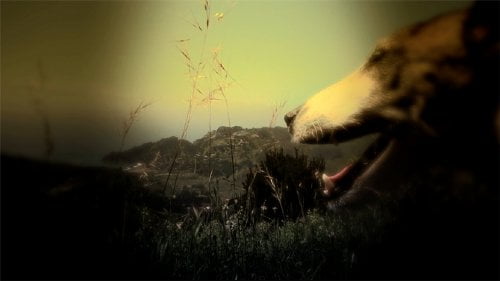Heart of a Dog

Visual and performance artist and filmmaker Laurie Anderson was once the owner of (or, in reality, owned by) a little rat terrier named Lolabelle. Anderson uses this long and loving relationship between a gal and her dog, an incredibly smart one, to tell of their life together and the events, 9/11 in particular, that took place during the pup’s lifetime in “Heart of a Dog.”
Laura's Review: A-
Almost thirty years after her "Home of the Brave" performance documentary hybrid, writer/director Laurie Anderson returns with a philosophical multi-media cinematic essay on death, grief, love and letting go through the lens of her own relationship with Lolabelle, the beloved rat terrier who died in 2011, in "Heart of a Dog." Anderson's moving and delightful reverie begins with her own animation of a somewhat creepy dream, one in which she gives birth to Lolabelle, telling the full grown pup 'I'll love you forever.' But the dream also surfaces feelings of guilt in what she put the dog through in order to accomplish this extraordinary delivery. From this she segues into thoughts on her own mother's death, her last words 'Tell all the animals...' The lasting emotions of 9/11 and the ramped up government surveillance which followed caused the NYC-based artist to temporarily move with her dog to the west coast, where an experience with an aggressive hawk changed Lolabelle's safety perspective - now she had to be aware of the sky, just as New Yorkers were that fated morning. The data collection which troubles Anderson is evoked again, as it is stored in 'The Cloud.' We get Lolabelle POV where the pup greets the many people that she knows, like 'the painter Julian (Schnabel) who lives across the street.' The camera also rests on her (and those who portray her) as, going blind, she is given piano lessons. The film's centerpiece features Anderson discussing Buddhist concepts and the Tibetan Book of the Dead's bardo, where souls stop for 49 days, as Anderson's art pieces depicting Lolabelle's post-death journey scroll by. Words and phrases appear on the screen, sometimes in sequence, sometimes seemingly jumbled, yet still making a point. We get quotes from Wittgenstein and David Foster Wallace. Anderson sings as well, her 'The Lake' accompanying old home movies which remind her of the time she saved her younger twin brothers when their stroller broke through the ice. Expecting to catch hell from her mother, she instead is praised, a memory which allows her the 'Mother Moment' which had eluded her. Another recollection brings her back to the burn ward she spent time in as a child with a broken back and how in telling the story over the years she had forgotten it, having stripped it to its essence. "Heart of a Dog" is a spiritual experience. One can feel the love that went into creating it. The film is dedicated to Anderson's late husband, Lou Reed, whose 'Turning Time Around' closes out the movie, its last image Reed and Lolabelle. Grade:
Robin's Review: B+
This is a meditation, by Anderson (wife of the late Lou Reed, to whom the film is dedicated), on love, with the charming and talented Lolabelle, and on life and death. The bulk of her story is centered on little Lolabelle, a dog that played the piano, painted and sculpted and Anderson’s world, often through her faithful companion’s eyes. Anderson also reflects on, as said, 9/11, but she also examines her inner self and our mortality and dignity. “Heart of a Dog” is not a linear documentary but an experiment on her life as a filmmaker and philosopher. The subject matter does not lend itself to a play at the multiplex – few there would understand or care about it. That, though, is not the audience the film is aimed at. The target is those, like me, who can appreciate the reflections of a person who has a personal something to say and, especially, about her love (understandable and deserved) for loyal little Lolabelle.

